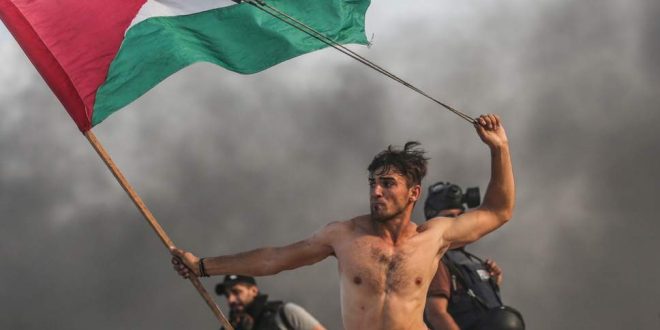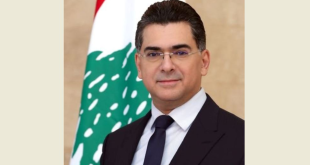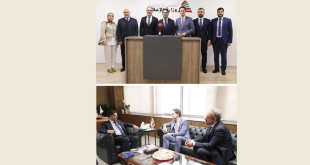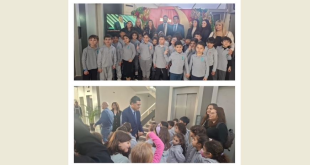“An 11-year-old child with his leg hanging on by a strip of skin was in one operating theatre where we were attempting a vascular repair, with an eight-year-old shot in the groin in a holding bay, when seven more arrived, also critically injured by sniper fire.”
These are the words of a top British orthopaedic surgeon, normally operating in a state of the art theatre at a London teaching hospital. He was reporting on a typical day of work at Shifa Hospital in the besieged Gaza Strip, where along with scores of other international surgeons, he volunteers to save the lives of Gaza protesters – and, increasingly, their limbs.
The limbs have been shattered by high velocity bullets, fired by Israeli snipers ranged along the barrier which separates Gaza from Israel, keeping 2 million Palestinians penned inside the strip, most of them refugees.
The protesters, part of the ongoing Great March of Return, are demanding an end to their imprisonment in Gaza, and a right to return to what was once – and they say still is – their land on the other side of the fence. In the six months since the protest began, 220 Palestinians have been shot dead, according to the Hamas health authority in Gaza, whose figures are accepted as broadly accurate by independent medical sources, including the International Red Cross (ICRC), but today it is the horrifying number of catastrophic wounds that is breaking Gaza.
Since the start, there have been more than 24,500 casualties, says the Gaza authority, with at least 5,300 protesters shot – by high velocity gunfire, more than a quarter of whom need major and repeated surgery if the leg has any chance of being saved. Hundreds have been amputated and many more of those undergoing surgery will yet lose limbs.
All the surgeons describe the wounds in almost identical terms. One says: “Usually in the knee. Bones smashed to bits, each fragment another projectile, leaving gaping holes through raw flesh, destroying soft tissue severing main arteries causing massive bleeding.”
The international medics also say they have never seen so many identical wounds of this severity, though many have worked in war zones. “I have worked in Rwanda, Bosnia, Afghanistan, Soweto and I have never seen such a high number of catastrophic limb injuries of the same nature – anywhere,” says Professor Tom Potokar, a plastic surgeon and head of the Centre of Global Burn Injury at Swansea University, who volunteers in Gaza.
The wounds are characteristic of explosive bullets, banned under international law, but are almost certainly caused by standard modern high velocity sniper fire, which on hitting young bodies at close range has an explosive effect.
“If they hit a knee there’s no bone to speak of left. The fire is strong enough to rip a leg off a youngster,” says another orthopaedic surgeon, who like several of the international doctors working now in Gaza, didn’t wish to be named, fearing that if he publicly criticised the shootings, the Israeli government would not let his team back through the tightly controlled Erez crossing, the only entry point from Israel into Gaza.
In all Gaza’s major hospitals, international burns specialists and anaesthetists are also working, usually alongside Palestinian colleagues, many of whom the internationals have trained. At all these hospitals, whatever part of the Gaza border area the wounded may have arrived from, the doctors confront the huge numbers of almost identical major wounds.
John Wolfe, a retired vascular surgeon from St Mary’s Hospital, London, now working for the Red Cross, describes how his day began trying to stem bleeding from a teenager’s main leg arteries “blown to shreds”. As he sewed skin with the finest needles he was worried all the time that Gaza’s feeble electricity supply would cut out before the emergency generator kicked in, thus breaking the electricity supply to essential coagulation equipment which was helping control the flow of blood from his patient’s small capillaries. If the bleeding started up again the leg would be lost.
Wolfe’s latest sniper-hit patient had already suffered two heart attacks in the ambulance on the way to Shifa, such was the rate of bleeding from a massive open wound to the knee. A newly trained Palestinian plastic surgeon was on standby to graft artificial skin onto the “raw meat”.
“A vast exposed wound is also a huge risk of infection,” he says. To make way for new patients the man would have to be moved back out into the community – into the dirt and dust – before the wounds had begun to heal. Wolfe didn’t know if the patient would live.
As operations in theatres continue, outside in the waiting area scores of others wounded, moved out of the overcrowded hospital wards just days after being treated for identical wounds, are back for further operations. Slumped in wheelchairs, stumps horizontal, or propped up on sticks by parents, legs bristling with metal pins inserted into bone, all dazed by heavy doses of the painkiller tramadol.
But the painkillers are not strong enough to numb the agony when a nurse removes bloody dressings. A father watches in tears as the boy wails. A mother asks a nurse: “Will he lose his leg? Please save his leg.”
Ahmad Abu Seidu, aged 18, enters the room, hobbling on sticks. One leg has four huge metal pins, the leg so heavy and swollen he cannot lift it. “I went to the buffer zone to see what was going on one day, and I got shot. That’s it. I regret it now. They’re going to amputate I think. And I’m supposed to be in high school,” he tells a local reporter.
“So sad. So difficult,” says a third British orthopaedic surgeon after at the end of a terrible day. His work in Gaza is unpaid, he volunteers to come during annual leave. He learned about gunshot wounds in Northern Ireland in the 1980s, but has also never seen the like of this.
It is now more than six months since thousands of Palestinians gathered near the Gaza border on 30 March for the start of the “Great March of Return,” organised to mark the 70th anniversary of the Nakba – or “catastrophe” – when Palestinians were expelled from their homes or forced to flee during the 1948 war which led to the creation of Israel.
More than 200,000 of these refugees fled to the Gaza area, evacuating nearby villages where they had lived for centuries.
In December 1948 the United Nations passed Resolution 194, asserting that the refugees, who fled also to Lebanon, Syria, Jordan and the West Bank, should return when fighting ceased, but Israel refused. Of the 2 million Palestinians now in Gaza, held there under different forms of illegal Israeli occupation since 1967, more than 1.4 million are refugees, either survivors of the Nakba or their descendants, the rest of the population imprisoned there are indigenous Gazans.
Since Hamas took local administrative control within the enclave in 2007, Israel transformed the nature of its occupation again. Having already withdrawn its troops from the ground, it now imposed a blockade by land and sea. The strip, just 25 miles long and seven across at its widest, borders the Mediterranean and will be uninhabitable by 2020, according to the UN.
As the siege has deepened and hopes of any compromise two-state peace deal have receded, the refugees unified increasingly around a call for the right to return to what they call their “48 lands”.
As crowds massed in March for the start of the Great Return March there were fears of retaliation from the Israeli side. Youths threw stones and sling shots towards the border fence, others tried to cut the fence: provoking and goading Israeli soldiers a time-honoured pastime for Palestinian youth.
When last in Gaza I talked to several youngsters planning to attend the protest; some seemed not to care if they were shot. “What’s to lose?” many asked. “We have no work, no money, no life in Gaza.”
But the focus for most ordinary Palestinians here was the anniversary of the Nakba, which they saw as a rare chance to regain some dignity by remembering their past, pitching tents to eat and dance, or carrying festive banners proclaiming names of their former villages.
“At first we thought it might make a difference,” says 52-year-old Hala Maghari, a mother of four and director of nursing for the United Nations Relief and Works Agency (UNRWA), responsible for Palestinian refugees, who was there on the first day.
Neither she, nor any Gazan, was prepared for what came next.
Before the protest began, Israel’s snipers were ranged at the fence, and by the end of the first day 60 of the protesters were dead and Gaza reeled. John Wolfe, the vascular surgeon, had been in Gaza training Palestinians in vascular surgery since the war of 2014, a time when Hamas leaders realised that far too many of the 2,020 dead in that Israeli onslaught had simply bled to death, through lack of medical expertise.
Four years later, Wolfe was to confront a situation in which he needed to train scores more and fast, to stem bleeding the likes of which he’d never experienced.
“I am hardened, I worked with victims of the Paddington train disaster, the Edgware Road terrorist bombing and the Harrods bomb. But nothing like this. My family tell me I was in a bad way when I got back home.”
One horrified British surgeon compared the scene to the massacre at Amritsar, where in 1919 the British Indian army fired their rifles into a crowd of unarmed Indians in the Punjab, famously depicted in the movie, Gandhi.
Since the first days, the protests have continued, as has the killing, though at a slower rate. Although the death count has slowed, however, horror of the shootings has only escalated further as injury figures showed a rapidly growing number of serious wounds to lower limbs, which Gaza hospitals simply could not cope with. On a single Friday – 26 October – 180 protesters were seriously wounded by high velocity bullets, with 655 wounded by gunshots throughout October, according to the Red Cross…
In the first 10 days of November the number of wounded has dropped, suggesting that Egyptian mediators may be succeeding in defusing tensions, through the provision to Gaza of more fuel and cash, but protests are now occurring on Mondays at the northern border near the sea shore, as well as on Fridays by the eastern fence. Meanwhile, Israel has made no promises of military de-escalation at the border and Gaza health chiefs remain over-burdened and are crying out for more equipment and more medics.
Hala Mughazi, the chief nurse who hoped for peaceful change in March, is instead overseeing the biggest emergency nursing response UNRWA has ever known in Gaza, organising treatment in clinics up and down the strip for thousands with “wounds so big you can put your hand through them,” she says.
Outside her clinics, pitiful groups of metal pinned figures gather daily along with others hobbling with the help of family. She herself has two nephews, and one cousin among the Great Return March wounded, all in the leg, and one now at risk of amputation.
Gislain Defurne, head of the Red Cross in Gaza, spells out the catastrophic consequences of these injuries for the victims and for the whole of Gaza. “It is overwhelming. You cannot compare what is happening here to what is happening in any other place. I do not know anywhere like it,” says Defurne, who has previously worked for the Red Cross in Darfur and Afghanistan.
Gaza’s situation is “unique” he says, describing how desperate, exhausted people all traumatised by recent wars and strangulated by the siege are living with no resources, no clean water, only six hours of electricity a day, and no hope of work or an end to the blockade.
“And then we have this number of injuries. If these injuries were happening on the streets of Paris or London their hospitals would not be able to cope. But they are happening here in Gaza. It’s impossible. For doctors it’s like working in a battlefield.”
The Red Cross has more than quadrupled its staff in Gaza in recent weeks, and constructed a special emergency clinic for the injured. Other international medical agencies have also geared up a huge emergency response, sending into Gaza as many qualified doctors as they can recruit, and as many as Israel will allow in.
The Norwegian charity Norwac is amongst international groups sending volunteers…
The Independent
 Lebanese Ministry of Information
Lebanese Ministry of Information



